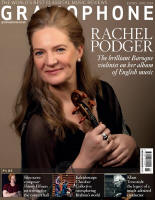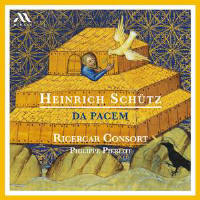Texte paru dans: / Appeared in:
|
|
 |
|
|
Though there is nothing wrong with presenting complete sets of Schütz’s monumental publications or large single works, it can be healthy for creative ensembles to choose the less well-travelled path of cherry-picking a mixture gathered around a theme. Philippe Pierlot takes a cross-section from three of Schütz’s major collections – an antiphon from Cantiones sacrae (1625), a concerto from Symphoniae sacrae II (1647) and three motets from Geistliche Chormusik (1648) – and puts them alongside several psalms, motets and sacred concertos that never appeared within the composer’s own printed opuses. While not quite arcana, these pieces receive infrequent contextual attention. The concept is prayerful music that originated during the tumultuous Thirty Years War (1618-48), although, to be fair, this period equates to the majority of Schütz’s industrious decades. All of the music is ideally suited to the Ricercar Consort’s five singers (alto parts allocated to high tenor), six string players (almost all using different viols) and continuo team of organ and theorbo.
Da pacem, Domine is an extraordinary double-choir antiphon composed for an electoral assembly held in Mühlhausen in October 1627: a soprano and five viols offer a serene petition for God to grant peace, which is then juxtaposed with a quartet of voices and organ exclaiming ‘vivat’ to six named electors and Emperor Ferdinand II. Later on, there is also Luther’s paraphrase of Da pacem, Domine (Verley uns Frieden genädiglich), published after the end of the long war in Geistliche Chormusik. Hanna Bayodi-Hirt and Yetzabel Arias, in partnership with two compassionate violins and continuo, produce penitential sublimity in Was betrübst du dich (Symphoniae sacrae II). An SATB quartet has refined simplicity in Domine, ne in furore tuo arguas me (Cantiones sacrae), whereas the sinewy full complement of viols and Matthias Vieweg are spellbindingly poignant in Herr, nun lässest du deinen Diener, a setting of the Song of Simeon for the funeral of the Kassel Kapellmeister Christoph Cornett in 1635. Likewise, a conversation between viol consort and soprano voice has heartfelt sincerity in Erbarm dich mein, o Herre Gott (a motet preserved uniquely in the Düben collection at Uppsala University). Five voices and a pair of rapturous violins generate serene bliss in Siehe, wie fein und lieblich ists, a concerto written for the Leipzig wedding of Schütz’s younger brother Georg and his bride Anna Grosse in August 1619. The influence of Monteverdi is evident in declamatory tenor duo passages in tandem with the other voices throughout Teutoniam dudum belli, a joyous hope for Apollo and the nine Muses to bestow prosperity after so many years of perilous war (the ceremonial motet was probably designed for use at Breslau in October 1621).
Charted intelligently to exploit contrasts while also drawing connections, the hourlong programme finishes solemnly with the psalm Herr, unser Herrscher, composed sometime in the mid-1630s at around the time that Saxony managed to disentangle itself from the worst effects of the war. If you want to hear it with five soloists doubled by Schütz’s optional ad libitum choir and four trombones, try the final volume of Hans-Christoph Rademann’s complete Dresden survey of Schütz’s works (Carus, 9/19). However, even without these extra resources, the Ricercar Consort’s conceptual miscellany is pretty much perfect. |
|




